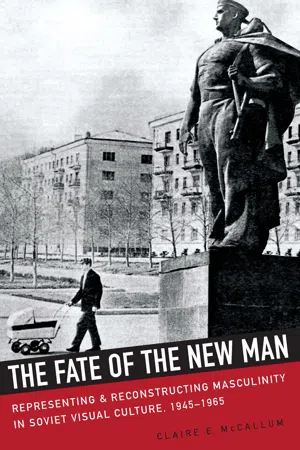
The Fate of the New Man
Representing and Reconstructing Masculinity in Soviet Visual Culture, 1945–1965
- 324 pages
- English
- ePUB (mobile friendly)
- Available on iOS & Android
The Fate of the New Man
Representing and Reconstructing Masculinity in Soviet Visual Culture, 1945–1965
About this book
Between 1945 and 1965, the catastrophe of war—and the social and political changes it brought in its wake—had a major impact on the construction of the Soviet masculine ideal. Drawing upon a wide range of visual material, The Fate of the New Man traces the dramatic changes in the representation of the Soviet man in the postwar period. It focuses on the two identities that came to dominate such depictions in the two decades after the end of the war: the Soviet man's previous role as a soldier and his new role in the home once the war was over. In this compelling study, Claire McCallum focuses on the reconceptualization of military heroism after the war, the representation of contentious subjects such as the war-damaged body and bereavement, and postwar changes to the depiction of the Soviet man as father. McCallum shows that it was the Second World War, rather than the process of de-Stalinization, that had the greatest impact on the masculine ideal, proving that even under the constraints of Socialist Realism, the physical and emotional devastation caused by the war was too great to go unacknowledged. The Fate of the New Man makes an important contribution to Soviet masculinity studies. McCallum's research also contributes to broader debates surrounding the impact of Stalin's death on Soviet society and on the nature of the subsequent Thaw, as well as to those concerning the relationship between Soviet culture and the realities of Soviet life. This fascinating study will appeal to scholars and students of Soviet history, masculinity studies, and visual culture studies.
Frequently asked questions
- Essential is ideal for learners and professionals who enjoy exploring a wide range of subjects. Access the Essential Library with 800,000+ trusted titles and best-sellers across business, personal growth, and the humanities. Includes unlimited reading time and Standard Read Aloud voice.
- Complete: Perfect for advanced learners and researchers needing full, unrestricted access. Unlock 1.4M+ books across hundreds of subjects, including academic and specialized titles. The Complete Plan also includes advanced features like Premium Read Aloud and Research Assistant.
Please note we cannot support devices running on iOS 13 and Android 7 or earlier. Learn more about using the app.
Information
Table of contents
- Cover Page
- Title Page
- Copyright Page
- Dedication
- Contents
- Illustrations
- Acknowledgments
- Note on Transliteration
- Introduction
- 1. The Living: Representing Military Comradeship and Male Homosociality after the War
- 2. The Damaged: Representing the Wounded and Disabled Soviet Man
- 3. The Dead: Representing and Remembering the Fallen Soviet Soldier
- 4. Homecomings: Representing Paternal Return, Reintegration, and Replacement before 1953
- 5. Fatherhood after Father Stalin: Representing Paternity and Domesticity in the Khrushchev Era
- Conclusion
- Notes
- Bibliography
- Index